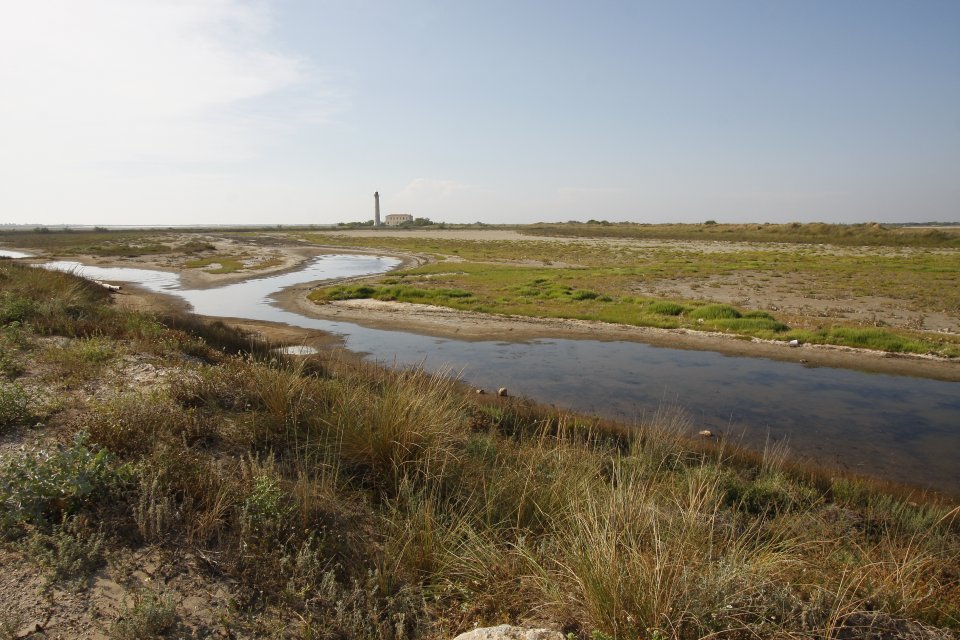
The former saltworks are located in the Rhône delta, in the Camargue Natural Regional Park. This site represents a vast coastal area of more than 6,500 ha in the communes of Arles (Salin-de-Giraud) and Saintes-Maries-de-la-Mer. Previously developed for salt production, the site is characterized by a strong artificialization of the water cycle (the Rhône river is canalized and dikes are used for protection) and a disconnection of the lagoons that were used as compartments for salt concentration.
1 Restore a more natural hydrological functioning that reconnects the surrounding hydrosystems (including the lagoons located further inland, the Mediterranean Sea and the Rhône River).
2 Restore the natural ecosystems characteristic of coastal lagoons and sandy coastlines, including dunes, salt steppes and saltmarshes.
3 Maintain or increase the carrying capacity for breeding colonial water birds.
4 Implement adaptive management to sea-level rise, creating accommodation space for water spread.
5 Contribute to sustainable developments, including facilitating the development of green tourism and recreational activities.
As the dikes and hydraulic structures inherited from the salt-mining activity were no longer adapted to the new objectives defined for the site, several actions were implemented to reconnect the water bodies. The principle activities included channel dredging, construction of water gates, rehabilitation of water gates and dike levelling.
Biological monitoring of the site is being implemented. Biologists and specialists on wetlands management, hydrology and ecological restoration have been working in the area of the former saltworks and have developed a solid understanding of population dynamics and the ecological status of the site.
The benefits of the restoration project for the society include:
- Enhanced flood protection further inland (creating a buffer zone),
- Development of fish nurseries (through increasing connectivity of water bodies and reducing salinity),
- New opportunities to improve scientific knowledge (research on coastal dynamics and biodiversity, and strategies to adapt to sea level rise),
- Increased prospects for environmental education (school and information visits), and
- Additional recreational activities (cycling, hiking, horse riding, etc.) both for locals and tourists.
- Developing climate change adaptation; improving risk management and resilience
- Better protection and restoration of coastal ecosystems
- Increase infiltration / Water storage
- Reduce flood risk
- Developing climate change mitigation
- Restoring ecosystems and their functions
- Creation of green jobs relating to construction & maintenance of NBS
- Increase amount of green open spaces for residents
- Increase awareness of NBS solution & their effectiveness and co benefits
- Increase communities’ sense of ownership
- Increase social interaction
- Increase stakeholder awareness & knowledge about NBS
- Increase well-being
- Increase willingness to invest in NBS
- Provision of health benefits
- Social inclusion
- Sustainable development of coastal regions
On the site, research has been conducted on biodiversity change, ecosystem functionality, stakeholder engagement and analysis of coastal dynamics. The results from this research provide evidence to support nature-based solutions and wetland restoration, towards the ultimate goals of improving biodiversity and adapting to climate change.
The former saltworks restoration project is an example of how humans can help to reverse a disturbance using NbS and adaptive restoration until nature recovers its functionality and resilience. In this case, reconnecting water bodies leads to the eventual reshaping of water paths in a natural way. Newly emerged soils and restored waterways produce “ new ” homes for vegetation, fish, birds and other wildlife populations. This coastal ecosystem becomes more resilient to work as a buffer and to mitigate the impacts of climate change.
- Rhone-Mediterranean-Corsica Water Agency
- Provence Alpes-Côte d’Azur Region
- Bouches-du-Rhône Departmental Council
- WWF-France
- Ministère de la Transition écologie et solidaire
- European Union
Marc Thibault: Thibault@tourduvalat.org
Lorena Segura: segura.env@gmail.com
